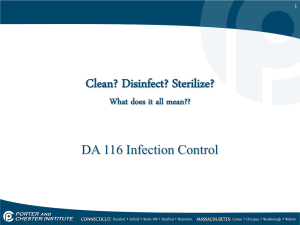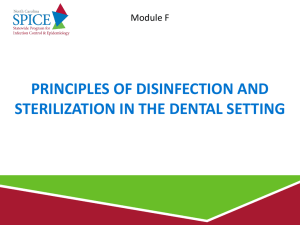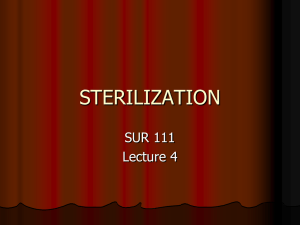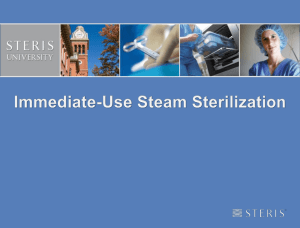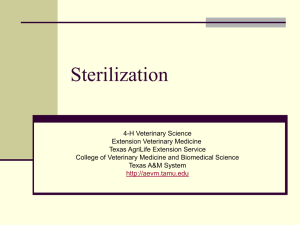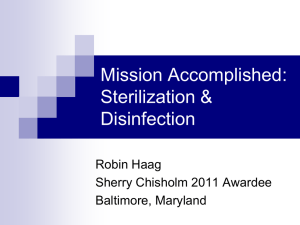Instrument Preparation and Wrapping
advertisement
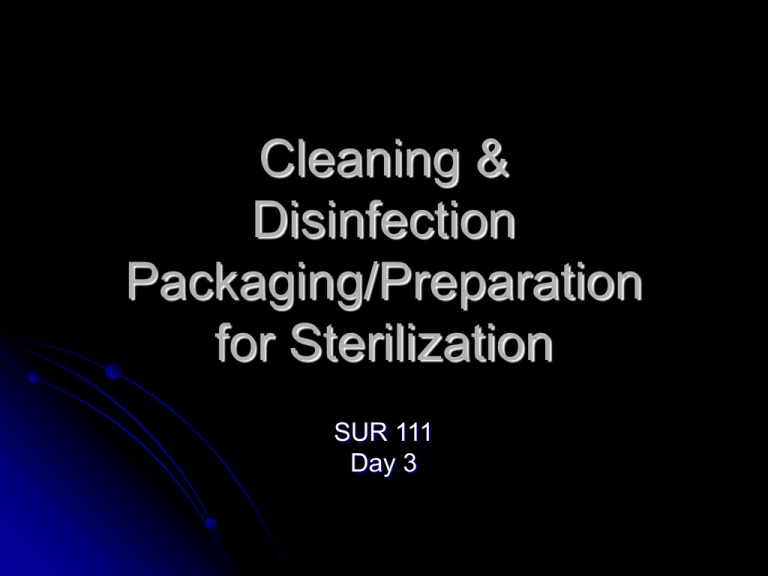
Cleaning & Disinfection Packaging/Preparation for Sterilization SUR 111 Day 3 Today’s Topics Cleaning Decontamination/Disinfection Packaging Items for Sterilization Definitions See Handout May need to refer to this during the lecture Familiarize self with these terms as you read or re-read your text Definitions Aeration - act of airing Ambient – surrounding atmosphere, the environment Animate – living Antiseptic – agent that inhibits growth of microorganisms on animate surfaces Autoclave – steam sterilizer Bacteriocidal – agent that kills bacteria Bacteriostatic – agent that inhibits or prevents bacterial growth Bioburden – number of microorganisms found in a specific area or on an item Delaminate –separate into layers Denaturation – change vital functions or activities of Definitions Disinfectant – agent that kills all microorganisms except sporebearing ones Ethylene Oxide (EO) – explosive, flammable gas used as a chemical sterilant Germicide - chemical agent that kills germs Gluteraldehyde – liquid agent used as a disinfectant or sterilant Inanimate – not living Ionizing Radiation – sterilization method used by manufacturers (Cobalt 60) Lumen – space within a tube Saturated Steam – steam containing the maximum amount of water vapor Shelf-life – the length of time a wrapped item is sterile while stored (dependent on type of wrap, number of layers, environmental conditions) •Sporicidal – agent capable of killing spore-forming microorganisms Definitions Sterilant – substance that kills all microorganisms, including spore-bearing ones Terminal Decontamination-process of rendering all inanimate items/equipment/surfaces free of pathogens at the end of an operative procedure; is usually done every other day or every week unless extenuating circumstances prevail (grossly contaminated room by TB, MRSA, VRSA, or a latex allergic patient that may be coming in next) Ultrasonic Cleaner-machine that uses ultrasonic energy and sound waves to clean instruments (called cavitation=dislodging, dispersing, and dissolving debris) Cleaning & Disinfection/Decontamination Process of Instrumentation Care Cleaning must occur before instruments or equipment can be disinfected or sterilized Consider grossly gunky food plates or a lasagna dish Have to clean it before you put it in the dishwasher or food-stuff will be washed on unless your dishwashers have teeth Cleaning-Decontamination Physical/manual, mechanical, or ultrasonic removal of blood, body fluids, gross debris (bio-burden) from an inanimate (nonliving) object Begins in the OR suite after a case or surgery is completed and clean-up begins Many ORs use an enzymatic spray agent Some may require that instruments be soaked in a detergent solution combined with water, before transported to the decontamination area of a hospital where decontamination ends Decontamination (terminal) ends after instruments/equipment are mechanically or ultrasonically cleaned in specialized areas of the hospital called decontamination (Decontam) areas or sterile processing departments (SPD) Cleaning-Decontamination Physical/Manual Universal precautions utilized (PPE) Assembled instruments are disassembled, left open, with ratchets, joints, or hinges released Any items with a lumen or space in a tube are cleaned with a brush internally Grooves must be soaked and scrubbed to loosen and remove debris Detergent must be non-corrosive and free-rinsing (instrumentation/equipment used in surgery often costs thousands of dollars) There must not be damage to items during this process! Heavy instruments MUST NOT be laid on top of delicate instruments Items are thoroughly rinsed and dried for storage until disinfection or sterilization occurs • Lumened items are blown out with an air gun/hose Cleaning-Decontamination Mechanical (Washer-Decontaminator) Washer-Decontaminator Tray used to lay instrument or equipment in Items are placed with box locks open, cutting edges protected, and assembled instruments, disassembled Items are ran through this machine that is manually or automatically fed with a low-sudsing, free-rinsing, PH of 7 (neutral), detergent Cleaning-Decontamination Ultrasonic (Sonic) Ultrasonic and high frequency sound waves clean instruments by process called “cavitation” where tiny bubbles from the sound waves dislodge, dissolve, and disperse soil from the instruments Instruments must be thoroughly rinsed as the debris are free-floating in the solution Rinsing Must be done with distilled water or sterile water, to prevent damage to the instrumentation or equipment Salt water or Normal Saline (NS) is corrosive Tap water is filled with minerals that are potentially corrosive as well Disinfection 1. 2. 3. Process of destroying microorganisms with the exception of spore-bearing ones, on inanimate objects Three Levels High Level- kills all microorganisms except spores, but may with sufficient contact time Intermediate Level- kills most microorganisms except spores Low Level- Kills fungi, bacteria, and hydrophilic viruses, with exception of other viruses and spores Uses Related to Levels of Disinfection High Level critical items such as those used in body cavities or on intact tissue Examples: surgical instruments, implantables, hypodermic needles Uses Related to Levels of Disinfection Intermediate Level semi-critical items that come in contact with mucous membranes or non-intact skin Not used in sterile tissue or body cavities Examples: colonoscope, laryngoscope, cystoscope (these areas normally have contact with the outside) Uses Related to Levels of Disinfection Low Level Non-critical items Contact only with inanimate surfaces or unbroken skin Example: BP cuffs, OR furniture Disinfection Effectiveness Presence of gross debris Bioburden or number of microorganisms in an area or on an object Temperature Instrument Preparation and Wrapping Instruments Instruments must be cleaned, checked for damage, and prepared for sterilization. Prep for instruments involves Inspection, reassembly, and Preparation. Inspection Items must be inspected for blood and gross contaminants Determine if the instruments need to be repaired or replaced Functional Testing Check scissors for burrs, cracks, and smooth closing. Check to ensure that ratcheted instruments work properly and not “sprung”. Ensure that “jawed” instruments close without gaps and even. Forceps tips should close evenly lined and grooved tips should be line to line with the other side. Self-retracting retractors should be checked to ensure that the retaining mechanism is working properly. Trocars should be checked for burrs, cracks, scratches, bends and sharpness. Powered instruments need to be checked according to the manufacturer. Reassembly Some instruments need to be taken apart before sterilization. Put them back together correctly. Ensure that all parts are exposed so that the sterilant can reach all areas. Preparation Sterilant must come in contact with all areas. Instruments must be positioned in a protective manner until used. Ensure instruments are evenly distributed in pan. Procedural Trays and Instrument Sets Procedural trays are for specific procedures. Usually has a few instruments. Can be laid flat on a stainless steel tray. Instruments should be placed in a wire mesh tray with a towel lining the bottom. Instruments Continued… Wrappers should not be used to line the tray because water will pool in the bottom of the tray pan. Instruments should be placed on a stringer. All ratcheted instruments must be placed in the open position. All like instruments should be placed together if possible. Micro instruments need to be kept in their own special tray. Lumened instruments require special sterilization techniques. Loose instruments in the bottom of a tray don’t need to be wrapped. This ensure all areas of the instrument can be sterilized. Instruments with concave sides should be placed on their sides for proper sterilization. Instruments Continued… Large instruments inside the pan need to be arranged to allow little movement. A absorbent towel may be used to position between large items. Manufacturers recommend that trays be no more than 16 pounds. Trays should be laid on a flat cart until used. Packaging for Sterilization and Storage Packaging refers the many types of materials used in wrapping to allow sterility and storage of reusable products. Wraps are class 2 medical devices set forth by the FDA. Wrapper Performance Wrapper must be able to maintain the sterility of items inside. Allows for easy removal without contamination. Must allow the sterilizing agent to reach all surfaces of the item enclosed. Performance Characteristics Efficiency Ease of opening Sterilization suitability Strength Barrier efficiency Impermeability Seal integrity Efficiency Conform to size and shape. Cover the contents. Maximum amount of use. When opened, wrapper must be flexible and memory free to prevent falling back onto the sterile item. Ease of Opening Allow package to be opened and transferred to the sterile field while maintaining sterility. Sterilization Suitability Must allow air to be completely removed form package. Must withstand physical conditions of the autoclave. Moisture, pressure, and high temperature. Must allow escape of sterilization agent. Materials must allow the contents inside to dry after sterilization. Must allow gas and moisture to escape after Ethylene Oxide sterilization. Strength Should resist tears and punctures during normal handling. Should not easily degrade during storage. Should not develop holes in folds and corners. Seals must not deteriorate and open during storage. Barrier Efficiency Should be a barrier to dust and particles. Should resist moisture penetration. Should be lint free to prevent contamination of items wrapped. Impermeability Must not contain dyes or toxins that could produce a reaction during sterilization. Must not cause items to become discolored from “bleeding” dyes. Seal Integrity Must permit integrity of seal. Peel pack pouches must be self sealing or sealing by heat or tape. Indicator tape or bind material must withstand the sterilization process. Broken locking devices should be easily detected. Seals must not be able to reseal after opening to prevent mixing of contaminated and uncontaminated items. Packaging Materials Wovens Muslin Paper Peel Packs Plastics Paper-Plastics Rigid Instrument containers Wovens Made of cotton and polyester blends. Reusable. Must be inspected every time it is washed. Holes must be patched, not sewn. Barrier protection decreases after each washing. Muslin Cotton fibers with 140 thread count. Unbleached, and double thickness is the best for steam sterilization. Single ply is not recommended. The space between threads is to wide. Double ply is the best choice. Woven Textiles with Barrier Properties Higher the thread count, better the protection. If single ply, use to wrappers. Use a towel between the item and the wrapper to absorb moisture and allow proper cool down to eliminate residual moisture. Nonwoven Materials Designed for single use. Made of plastic synthetic fibers. Paper Single use. Has extreme memory. Does not have the flexibility. Easily penetrated by steam. Paper or Cloth Wrap Styles Envelope fold for smaller items Square fold for larger items Peel Pack Pouches Paper Plastic combination. Used in Steam and EtO sterilization. Tyvek-plastic combination used in only EtO sterilization. Plastics will melt in the steam sterilizer. Peel Packs Continued… One side is paper, one side is plastic. Must be minimum of two millimeters thick. All edges need to be heat sealed. Opening may be self sealing or heat sealed. Staples should not be used to seal packs. Items should be placed inside pack so that the end of the item is grabbed when opened. Select the right size pouch for the job. Use a felt tipped marker on the plastic side to prevent leak through. Peel Packs continued… Remove all excess air from pouch before sealing. Cover all sharp edges on instruments to prevent tearing and contamination of item. Never use latex to protect tips of items. Double peel pack when possible. Peel packs should be placed on their edge and positioned plastic to paper side to allow proper cool down. Rigid Containers Has locking lids. Provide containment of items. Assurance of sterility. Cannot be torn or compromised. Easily opened and provide presentation of items. Used to return and contain contaminated instruments. Rigid Containers Continued… Load should be dedicated to all rigid containers. Drying phase should be increased to allow for moisture and condensation to exit the container. Prevacuum should be used. Gaskets on tray lids need to be inspected. Packaging After laundering, woven fabrics must be stored for 2 hours at 64-72 degrees F and 35-70% humidity. Maximum size pack is 12x12x12 and not weight more than 12 pounds. (Rule of 12) Linen packs must be packed loose to allow all surfaces to be sterilized. Double wrapping is best for proper sterilization and protection. Check package integrity before opening. Basin sets need to be separated by towels. Packaging Continued… Use the square fold and the envelope fold to wrap items. Always label items wrapped. Included contents, shelf life indicator, date, ID of sterilizer, cycle number, initials, and department were items are to be sent. Label gun labels have Julian date, ID of sterilizer, and cycle number on them. Intro to Sterilization Methods Sterilization Daniel Stokoe, CST, A.A.S. Contributors Sue S. McManus, RN, CEH, CSPDM Nancy Chobin, R.N., CSPDM Zelva Lee, CSPDT, CSIT AAMI Association for the Advancement of Medical Instrumentation, dedicated to increasing the understanding, safety, and efficacy of medical instrumentation. Makes many guidelines and requirements that effect policies in your department. Sterility Sterility is the absence of all forms of microbial life, INCLUDING bacterial spores. Spore: a dormant resistant form taken by some bacteria in response to adverse conditions. These are very hard to kill. Saturated steam (most water vapor possible) is heated to greater than 250˚ F or 121˚ C Steam at atmospheric pressure only has a temperature of 212˚ F or 100˚ C In the autoclave, this pressure is increased to 15 to 17 pounds per square inch and increases the temperature to the required degree Sterilizers Usually located in the prep and packing area, adjacent to the sterile storage area. Many Types: Steam ETO – Ethylene Oxide LTGP – Low Temp Gas Plasma – Sterrad Peracetic Acid – Steris others PA - Steam Sterilization Steam sterilization is accomplished by saturating steam under pressure. Steam kills microorganisms by denaturing (to change the molecular structure and characteristics of a molecule by chemical or physical means) the protein. Saturated steam permeates material within the chamber and transfers heat to the instrument or material being processed. Steam Sterilization Should always be the preferred method of sterilization unless otherwise directed by the manufacturer of the device. Should always follow the sterilizer manufacturers directions for operating the sterilizer. Steam Sterilization Follow device manufacturers instructions for cleaning procedures. Items must be cleaned before being introduced to the sterilization process. Parameters for Steam Cycles Time – Temperature and Pressure Time varies with temp. Lower the temp, the longer the exposure time. Atmospheric pressure affects chamber pressure. Special cycles for liquids – requires gravity cycle with slow exhaust. Parameters for liquids Not usually sterilized in facilities today. Follow manufacturer instructions. Liquids can only be processed in a gravity displacement liquid cycle. Slow exhaust to prevent rupture of the container at the end of the cycle. Special Pyrex glass containers, which can withstand very high temps will be used. BI should be included in the load. Steam Sterilization Phases of sterilization cycle: Conditioning Phase: air is removed form the chamber and steam is injected. Exposure Phase: Temp is maintained for appropriate amount of time. Exhaust Phase: Steam exhausted through the chamber drain line. Drying Phase: lasts about 30 minutes. In pre-vac – filtered air is drawn into the chamber. In gravity displacement – the heat in the sterilizer walls causes moisture to evaporate. Steam Quality Saturated steam having a quality of 97% saturated steam with 3% entrained water Requires adequately placed steam traps Insulated steam lines (especially if the steam is generated at a long distance from the sterilizer) Steam Quality Can be the cause of wet packs Steam separator may be needed to remove excess entrained water Steam separator should be placed in steam supply piping as close as possible to the sterilizer. Steam Purity Only additives/conditions approved for use in the food industry should be used. Steam lines should not have “dead legs” which can harbor contaminates and microorganisms. Steam Purity Procedures for monitoring steam purity should be established In line steam filters should be considered Purity of steam should meet or exceed standards set in ISO 17665-1:2006 (specifies requirements for the development, validation and routine control of a moist heat sterilization process for medical devices. ) Steam Purity ISO 17665-1:2006: Moist heat sterilization processes covered by ISO 17665-1:2006 include but are not limited to: saturated steam venting systems; saturated steam active air removal systems; air steam mixtures; water spray; water immersion. Steam Contaminates hydrogen sulfide, ammonia, carbon dioxide, other gases, and finely divided particulate solid matter in a form resembling dust or smoke are contaminants that reduce the efficiency of the steam as a heat transfer fluid, are detrimental to equipment utilizing steam as an energy source, and result in environmental pollution or expensive requirements for limiting the same. Differences in Cycles Pre-vac depends on mechanical removal of air form the chamber and packs. Gravity – air displaced by steam with gravity as the force pushing the air out. Greatest resistance to steam sterilization is removal or air! Pre-Vac Cycles Time: Usually 3-4 minutes exposure time Temp: 270-274 degrees Fahrenheit Pressure: 28-30 psi Wrapped devices Drying time is dependent on your facility and load content – Hepa filtered air. HEPA =‘s High-efficiency particulate air (filters) Gravity Displacement Cycle Time: 20-30 minute exposure Temp: 250 degrees Fahrenheit Pressure: 15-17 psi Wrapped items, poor drying – takes place by evaporation through chamber walls. Steam Sterilization Cycle parameters for wrapped or containerized items Follow manufactures directions for cycle times/temps These may differ from your regular cycle time/temps. Steam Sterilization If a sterilization container system is used as a packing, the container manufacture’s written recommendations for exposure time should be consulted and reconciled with those of the sterilizer manufacturer. Flash Sterilization “Flash sterilization” should be carefully selected to meet special clinical situations Should only be used when there is insufficient time to sterilize an item by the preferred, prepacked method Flash Sterilization cont. Should not be used as a substitute for insufficient instrumentation. (AORN) Proper decontamination activities and facilities need to be provided Steam Sterilization Some types of equipment (i.e. power drills) may require longer exposure time – run these separately form a normal load. Must have manufacturers written instructions for all devices sterilized in your department. Flash Steam Cycles Pre-vac: 270 degrees Fahrenheit: metal, non-porous items, no lumens = 3 minutes Metal with lumens, porous items, sterilized together = 4 minutes Flash Steam Cycles High speed gravity – 270 degrees Fahrenheit – metal, non-porous items, no lumens = 3 minutes Metal with lumens, porous items, sterilized together = 10 minutes Must consider the use of Flash containers. Special Cycles Prions Prions: are an infectious particle of protein that, unlike a virus, contains no nucleic acid, does not trigger an immune response, and is not destroyed by extreme heat or cold. These particles are considered responsible for such diseases as scrapie, bovine spongiform encephalopathy, kuru, and CreutzfeldtJakob disease. Special Cycles Prions Prions – when dealing with instruments that have been exposed to matter that could contain Prions (most often brain material), a system must be in place to easily ID and separate form other instruments. Must be processed by: prevac – 18 minutes at 273 degrees Fahrenheit or Gravity displacement – 1 hour at 250 degrees Fahrenheit. Lumens hard to clean – many O.R.s will use disposable items. Must keep a log f Prion exposed items. Drying Select drying times per manufacturers instructions May have to amend time based upon conditions in your facility. Relative humidity, packing and loading techniques can effect drying Rigid containers will affect drying times Wet Packs 3 scenarios; visible moisture on outside of packs; moisture inside pack; visible water inside tray. All are considered contaminated Other causes; improper packing, set configurations, weight of trays, use of rolled towels on sets, non-absorbable wicking material, etc Preparation of Devices All hinged instruments open Multi-part items disassembled Lumens verified for cleanliness then flushed with sterile distilled water immediately before sterilization Select chemical indicator based upon the sterilization process. Loading Sterilizers Load items loosely Containers should only be stacked if recommended by manufacturer No metal items over linens Peel packs on their side and in separator Basins, solid trays on their sides; mesh pans flat HINT: REMEMBER LINEN OVER LINEN, BASINS OVER BASINS, LINEN OVER INSTRUMENT OR BASINS BASINS ALWAYS ON BOTTOM EXCEPT BASINS OVER BASINS Peel Pack Separator Removal of Items form the Sterilizer Items/packs removed from the sterilizer should be visibly dry Avoid directly touching items when hot Never place hot items on cool surfaces, condensation will form. Allow to cool before handling. Steam vapor remaining in packs can cause condensation to form. IF YOU MUST REMOVE AN WARM ITEM, USE STERILE GLOVES AND STERILE TOWELS FOR TRANSPORTING Cooling of Items Allow load to remain inside sterilizer with door cracked for at least 10-20 minutes. Wrapped items being cooled after removal form the sterilizer must remain on the cart, untouched, during the cooling off period – can be as long as 2 hours. Cooling of Items Items being cooled should be in a low traffic area- no A/C or cool air vents nearby Time for cooing should be based on professional judgment, experience and the environmental conditions of the area. Handling and Inspection Never handle sterile items before they are cool Handle as little as possible there after All packages should be visually inspected for integrity and dryness Any packs which appear torn, wet, compressed or punched should not be used. Handling Inspection Any packs which appear to have been open or appear to have breached seals should not be used. Any item which drops to the floor should not be used. All such items should be completely reprocessed. Physical Monitoring Includes time Temp and pressure recording devices and gauges. Operators should label charts/printouts with sterilizer number and dates. At end of each cycle and before items are removed, operator must exam/record and verify parameters met. Place initials on form Chemical Monitors Should be used with each package (inside and out) Designed to detect problems associated with incorrect packaging, incorrect loading malfunction. Not a sterility test Use indicators designed for the cycles used (wrapped vs. flash) Chemical Monitors Bowie-Dick Test – now called D.A.R.T (Dynamic Air Removal Test) required daily for all pre-vac sterilizers. Only test the ability to remove air form the chamber. Chemical Indicator, chemical integrators monitor the process. Autoclave tape – external indicator Chemical Monitors Classes 1-5 Processes indicators (Class 1)-example autoclave tape- differentiates processed vs. non processed devices. Indicators for specific tests (Class 2) for example D.A.R.T. Chemical Monitors Single Parameter indicators (Class 3) are designed to react to one of the critical parameters and to indicate exposure to a sterilization cycle at a stated value of the chosen parameter. Multi-parameter indicators (Class 4) are designed to react to 2 or more critical parameters of the cycle. Chemical Monitors Integrating Indicators (Class 5) designed to react to all critical parameters over a specified range of sterilization cycles; performance correlated to the performance of a BI under the same conditions of use. Biological Monitors Intended to demonstrate whether or not the conditions in the sterilizer were adequate to achieve sterilization A negative BI proves that all items in the load were sterile or all exposed to adequate sterilization conditions Biological Monitors Use Bi’s for the type of cycles you use; control for verification Steam cycles – Geobacilis Stearothermophilus Must use manufactures instructions for use, storage, handling and incubation Verify temps of incubator routinely Document results with initials Biological Monitors Frequency - at least weekly Will be placed in all loads containing implantable devices. Implantable devices should be quarantined until BI results are known. Verify that the control and the vial are from the same lot # Need to test pack with a Class 5 CI for all implant loads. BI test packs now called Process Challenge Devices (PCD’s) Biological Monitors Installation Testing: Three consecutive cycles must be negative 3 BI’s followed by 3 D.A.R.T.’s in empty cycles DO NOT USE sterilizer until all BI’s test negative. BI Testing Must be done after major repair which is defined as repair outside the scope of normal maintenance such as weld repairs, repairs of pressure vessel, replacement of chamber door or major assembly; rebuilds or upgrades of controls. Biological Monitoring Most HCF’s use manufacture’s test packs containing a BI. Control BI is needed to verify the presterilization viability of the spores Use BI’s in fully loaded chamber – exception – flash cycles Biological Monitoring Position BI test pack in the coldest part of the sterilizer. This area will vary with the design of the sterilizer. Check with the manufacturer. Normally in the center of the load towards the front of the chamber BI for steam requires higher incubation temperature (55 to 60 degrees Celsius or 131-140 degrees Fahrenheit) Biological Monitoring Document all installation and routine testing by date Verify results of control vials When positive BI occurs, all items processed since the last known negative test must be considered non-sterile, retrieved if possible and re-processed Sterilization Logs All items processed in wrapped or unwrapped cycles need to be documented. Recall Policy – needs to be developed in the event of a recall Follow-up of patients for recalled items should be conducted. Review log and printouts each day Packaging Muslin Paper wrap Peel pack Ridged Containers – for steam NO plastic (Tyvek) or Nylon Record Keeping Document all items processed Specify department, quantity and description of all items per load. Affix proper sticker (ERS?) Save all print outs BI testing, Bowie Dick test Keep records neat NO WHITEOUT Lot Control Place lot control sticker on items before placing on sterilizer cart. Verify load and sterilizer # are correct Sterilizer Maintenance Need good PM program by reputable service agent Need to keep sterilizer clean Inside chamber weekly Drain line basket daily Door gasket daily Exterior surfaces daily Carts/ carriages weekly. Summary for Steam Sterilization requires all parameters to be met. Operators of sterilizers must monitor cycles and verify proper conditions. Sterility maintenance is event related; sterility maintenance is on going. Proper handling of packs after sterilization is critical. Summary Proper cleaning of essential components is required for proper sterilization. Competencies for effective sterilization practices need to be demonstrated. Either an item is sterile or not. Can not rush the process, especially the decontamination process. Dry Heat Sterilization Not often used in facilities today Why: Uses very high temperatures (bad for some instruments) Long exposure times are needed due to lack of moisture (a.k.a. steam). Find more info: page 204-205 Best Practices for Low Temp Sterilization Choices: Ozone ETO – Ethylene Oxide Gas Low Temp Gas Plasma Peracetic Acid Ozone Sterilization Low Temp sterilization that was cleared by the FDA in 2004 Ozone is oxygen, with an extra atom (O3) Electricity is added to ozone, to help kill bacteria, fungi, viruses, and spores. Has pungent odor (people smell it after a lighting strike) Advantages of Ozone Low cost of installation No special ventilation ( uses only oxygen, water and electricity) No toxic fumes or hazardous by products No disposal costs Disadvantages of Ozone Limited penetrability Potential for metal corrosion Degradation of some plastics due to high humidity (70%-90%) Concentrated ozone can be hazardous to humans and is a respiratory irritant. What to sterilize with Ozone Stainless Steel Inst. Hinged instruments Instruments with stainless steel lumens (single lumens defined inner diameter, length and relationship between inner diameter and length.) What NOT to sterilize with Ozone Flexible endoscopes Implants Ampules containing liquids Natural rubber and latex Woven textiles Devices made of the metals copper, zinc, nickel or metal foil Containers with cellulose filters Consult the manufacturer Ozone Sterilization Cycles Parameters are: ozone concentration, temp and time. A preconditioning phase 2 half cycles consisting of vacuum, humidification, ozone injection and ozone exposure. At the end of the second half cycle, the chamber vents, removing the ozone, completing the process. Ozone is converted back into safe O2 Wrapping for Ozone Acceptable materials include nonwoven or noncellulose wraps Polyethylene pouches Anodized (A process that hardens the outside surface of a metal part) Aluminum sterilization containers with disposable non-cellulose filters. Monitoring for Ozone Cycles Appropriate CI’s Standard BI’s (Geobacillus stearothermophilus) Make a test packet: Place BI into catheter tip syringe. Cap of the BI is inserted first. Plunger is placed in syringe Place syringe into a sterilization pouch along with the appropriate CI. Seal pouch. At the end of the cycle, incubate BI. Read at 24 and 48 hours. ETO Chemical agent used for sterilization for heat, pressure, or moisture sensitive item. A member of the ether family A.K.A. Epoxide A liquid that at room temp becomes a gas. Uses of ETO Sterilant Fumigant and pesticide To control molds and fungi in producing fruits, nutmeats, egg powders and tobacco In the production of antifreeze, polyester fibers and films. Type of ETO used in Sterilization 100% undiluted in unit dose cartridges Becoming the most commonly used in hospitals since the ban of CFC’s I 1995 because of their ozone depleting action. ETO Mixtures Mixtures with inert gases such as HCFC’s and Carbon-Dioxide (CO2) HCFC’s banned after 2023 in US. There are stability and pressure issues with CO2 mixtures. Characteristics of 100% ETO Completely soluble in water at 50 degrees Fahrenheit. Must use Bacillus Subtilis In presence of an acid or alkaline catalyst it can react with water to form ethylene glycol or ethylene chlorhydrin (characterized by brown residue). Flammable at liquid and gaseous state Characteristics of 100% ETO Has the ability to be absorbed by may materials. Colorless Liquid form causes server burns. In the gaseous state it is moderately toxic under the conditions of proper use. Characteristics of 100% ETO Most people can not detect the odor until it reached level of 700 ppm (PPM =‘s: number of grams of a dissolved substance in 1000 liters of water) Explosive in mixture of air in 3% to 80% The explosiveness can be eliminated by mixing ETO with inert gases. http://video.google.com/videoplay?docid=43585565522259544&q=Ethylene+oxide+explosion&t otal=1&start=0&num=10&so=0&type=search&plindex =0 Storage/Handling of 100% ETO Provided in unit dos cartridges. Stored and used I well ventilated areas with a minimum of 10 air exchanges per hour. Can keep 10-12 cartridges in the department Storages of bulk supply of gas (excess of 12 cartridges) should be as a Class 1 Flammable Liquid. Storage/Handling of 100% ETO Cartridges should be aerated at the end of the cycle as well as the gloves used to handle the cartridge. Neoprene gloves should be used. Google are also recommended when transferring items to an aerator. Use goggles and gloves when handling cartridges. Storage/Handling of ETO Mixtures Supplied in large cylinders or tanks. Cylinder must be secured. Should be stored at room temperature Storage areas must be well ventilated with 10 air exchanges per hour. Care must be taken when changing cylinders to avoid accidental exposure. Achieving Sterility with ETO Items must be clean before sterilization. Materials to be sterilized and packaging should be maintained in an environment of relative humidity of at least 50%. Items to be sterilized must be completely dry. Achieving Sterility with ETO All traces of lubricants must be removed. Select appropriate packaging materials: Most wrappers acceptable for steam are also acceptable for ETO Can use Polyethylene (may not exceed 3 mm’s in thickness) Tyvek Do not use Nylon, Polyester (Mylar), PVC films or Styrofoam. Packaging for ETO Sterilization Make sure packaging is performed in a manner that conforms with the standards for packaging products for sterilization. Packages must be wrapped in a manner that provides for aseptic handling and protection of package contents until use. Packages must be wrapped in a manner that allows for adequate penetration and subsequent release of the sterilant. Packaging for ETO Sterilization If using trays for containing items, make sure they are perforated and lay flat in the sterilizer. If using container, make sure they are tested in your sterilizer. Loading the Sterilizer Do not overload Load in a manner that allows the sterilant to circulate and reach all surfaces of the package easily. When using paper peel pouches: Place them on edge If working with large chamber sterilizer, place them in basket. Loading the Sterilizer When using paper peel pouches: The plastic side of one pouch should face the paper side of the pouch next to it. Do not stack pouches on top of each other Monitoring the Sterilization Process Chemical indicator must be included with each item sterilized. A lot label (#) must be on each package sterilized. BI testing must be performed for each load processed. Sterilization Cycle Parameters for ETO Sterilization The parameters vary significantly from sterilizer manufacturer to manufacturer. OSHA regulations require that operators of the sterilizer must demonstrate competencies in all of the parameters of ETO sterilization as well as a comprehensive knowledge of the system in use. Sterilization Cycle Parameters for ETO Sterilization Gas concentration: Exposure time: 450 mg per liter to 1500 mg per liter. 48 minutes to 12 hours. Humidity: 50% to 80% (55% chamber humidity ideal) Critical to the penetration to bacteria cells and successful sterilization. Sterilization Cycle Parameters for ETO Sterilization Temp: Ambient room temp 70 -149 degrees Fahrenheit Pressure: 5 PSIG to 28 PSIG Most Common Cycle Parameters for ETO Sterilization The cycle parameters most commonly found in hospitals today are: Exposure time – 105 minutes ( 1 hour and 45 minutes) Temp – 130 degrees Fahrenheit Concentration – 600-700 mg per liter Humidity – 55% Pressure – 8 PSIG ETO Kills by Alkylation Changes of the chemical structure of the organism by taking hydrogen from it. In order to accomplish this, the ETO must penetrate the cell wall. Prevents the organism form normal metabolism causing the organism to DIE. Cycle Phases of ETO Sterilizer Vacuum – air is removed from the chamber and packages. Humidification – a small amount of moisture is added to the chamber Introduction of the sterilant – ETO inters the chamber. exposure period –load held at time, temp, and concentration. Final vacuum – the chamber is purged repeatedly to remove the sterilant Aeration – some types of units have internal aeration mechanisms, others you have to remove the sterilized items and transport to a aeration chamber. Unloading the ETO Sterilizer Transfer good to aerator ASAP after the sterilization cycle is complete. All items must be aerated Package and good absorb ETO Materials release ETO at different rates. Residuals must be removed for patient and staff safety Unloading the ETO Sterilizer Unloading the sterilizer (prior to aeration) represents one of the greatest hazards for potential employee exposure hazard The other is while changing cylinders Because of the various sterilizers in use today, aeration may be accomplished in several ways. Unloading the ETO Sterilizer Sterilizer with aeration cycles: Unit will first go into a three hour aeration cycle, during which the unit can not be opened. At the end of this cycle, the unit will signal that the cycle is complete and the goods may be transferred to an aerator. At this point you can remove the BI. Unloading the ETO Sterilizer If the sterilizer is need for another load the goods may be transferred after the first three hours. If your sterilizer has a purge cycle and no aeration The goods should be moved to an aerator within 15 minutes of the cycle. Unloading the ETO Sterilizer If your unit does not have a purge cycle Open the door approx 6 inches at the end of the cycle. The immediate vicinity of the sterilizer should be vacated for approx 15 minutes. Load should be transferred to an aerator at the end of the 15 minute period. Unloading the ETO Sterilizer BI test vials may be removed and incubated prior to aeration. Gloves should be worn when handling the test pack and vial If handling packages the gloves should be neoprene. Protective eyewear should also be worn during this process when breaking the vial. Gloves/eyewear and the remainder should be aerated. Unloading the ETO Sterilizer If unit odes cartridges are used it should be placed on top of the load in the aerator. If using the cart to transfer to goods to an aerator, pull it behind you, do not push. Aeration 2 types: Ambient or Room Temp without benefit or Air washes Dedicated room and exhaust mandatory. Minimum of 10 air exchanges mandatory. 7 days needed to complete process. Should not be used prior to the 7 days. Mechanical aeration cabinet Dedicated exhaust Continuous filtered air washes Aeration Temp controlled 122 degrees Fahrenheit for 12 hours 130 degrees Fahrenheit for 10 hours 140 degrees Fahrenheit for 8 hours Check with the manufacture of the item you are aerating for recommendations Never assume. Problems Associated with ETO Ethylene Chlorhydrin Water must be present for this to occur Occurs when items are improperly aerated and they are exposed to saline or body fluids. Solution Items for ETO sterilization must be dry Proper aeration must occur Safe Use of ETO ETO must be used with care and only when the device manufacturer recommends this type of sterilization. Sterilizer operators must be able to demonstrate the properties and hazards of the gas and the sterilization process. Safe Use of ETO Adhere to strict procedures and controlled conditions: Proper equipment Proper training Proper preparation Proper packaging Proper sterilization conditions Proper aeration OSHA Regulations Leak Detection Should be performed and recorded every two weeks for pressurized systems Make sure your detector is specific to the type of ETO your using 100%- ETO specific Mixtures- detect HCFC’s Should be done during sterilizer operation OSHA Regulations Leak Detection Leak detection should be performed: Around the sterilizer door gaskets Around the vacuum piping hose Around the filters Around safety valve and other valves such as tank valves After changing cylinders to be sure connections are tight. Low Temp Gas Plasma Sterrad =‘s LTGP Low Temp Gas Plasma Sterrad - LTGP Plasma =‘s an ionized gas where the electrons in the atom are separate from the nucleus. It is the fourth state of matter. Cleared by FDA in USA since 1993 Uses hydrogen peroxide energized into a plasma to kill microorganisms by oxidation. New larger size chambers with shorter cycle times. Low Temp Gas Plasma All devices processed in LTGP must be thoroughly cleaned and dried. Any moisture remaining in devices can result in abortion of the cycle. Compressed air can be used to force moisture out or lumens and other hidden places. Must use medical grade air. Low Temp Gas Plasma Only those devices which meet the clearance for the LTGP system and or are cleared by the device manufacturer should be processed. Parameters for LTGP For the Sterrad 100-S model Time : 45-50 minutes depending on load Temp: the sterilizer operates at temps below 122 degree Fahrenheit (50 degree Celsius) Sterilant: the system uses a multi-dose cassette containing 10 single does of liquid 59% Hydrogen Peroxide. LTGP Phases Vacuum: All air removed from the chamber and packages until the pressure is reduced below atmospheric pressure. Injection: Once the correct pressure has been reached, a premeasured amount of concentrated (59%) Hydrogen Peroxide (H2O2) is pumped from the cassette into the vaporizer bowl and vaporized into the chamber. LTGP Phases Diffusion: The diffusion stage drives Hydrogen Peroxide vapor into the small crevices and lumens of the devices in the chamber. The chamber will return to atmospheric pressure to accomplish this. Plasma: Vacuum decreases the pressure and radio frequency (RF). Energy is radiated in the chamber form the electrode screen. The RF energy ionized the Hydrogen Peroxide, created the Hydrogen Peroxide Gas Plasma and leads to the generation of free radicals and other chemical species which destroys organisms. LTGP Phases The Injection/Plasma phases are repeated a second time. Vent: At the end of the second sequence, the RF is turned off. Air is then vented into the chamber thru bacterial HEPA filters, returning it to atmospheric pressure. LTGP Phases At the end of the sterilization cycle: A 10 second continuous alarm sounds, alerting the operator that the cycle is completed and the items can be removed from the sterilizer. The printer prints out the summary of the cycle parameters. The operator can then open the door, remove all the sterilized items and close the door. LTGP Packaging materials Instrument trays used in the LTGP should be designed to optimize diffusion of the Hydrogen Peroxide and not interfere with the RF energy or absorb Hydrogen Peroxide. Do not use linen, paper wraps, peel packaging materials or cellulose based materials ( like cotton balls) Check with tray manufacturers before purchases/use of containers. Use only non- cellulose based filters and ridged containers. LTGP The following package materials are compatible with LTGP: Trays from the sterilizer manufacturer Tyvek (all plastic) pouches NO PAPER-PLASTIC POUCHES Polypropylene based wrapped and filters LTGP Items which can be processed in LTGP: Items which are recommended by the device manufacturer The sterilizer manufacturer does not recommend processing devices with: Lumens or channels longer than 17 inches and inner diameter 1/8 inch. Do not process in LTGP Any device with dead-end lumens Cellulose based material ( cotton, paper, gauze) Liquids Items that do not meet the lumen/length criteria Any organizing trays that contain cellulose based material Implants Do not process in LTGP Paper load control stickers (unless plastics/Tyvek) Count sheets (unless plastics/Tyvek) Traditional adhesive labels (like dust cover labels) Any instruments/devices labeled specifically for Gravity displacement sterilization. Loading the Sterilizer Arrange load so that metal items are in a single layer and do not touch the walls, doors, or electrode of sterilizer. The most effective sterilizer performance is achieved when the load contains a mixture of metal and plastic items. Loading the Sterilizer Ensure that the sterilizer chamber is not overloaded. No paper or cellulose material should be placed in the sterilizer chamber. All peel pouches should be placed on the edge if possible, with the plastic face of one pouch facing the clear side of the next pouch. Sterrad NX Now Sterrad NX is available. The STERRAD NX System is the fastest low-temperature hydrogen peroxide gas plasma sterilizer yet. Two cycles: Standard 28 minutes Advanced 38 minutes Sterrad NX Standard cycle requirements: Stainless steel lumens having a inside diameter of at least 1 mm and length at most 150 mm. Polyethylene or Teflon lumens having an inside diameter of at least 2mm and length of at most 400 mm. Sterrad NX Single channel flexible endoscopes can be processed in the advanced cycle. Stainless steel lumens having an inside diameter if at least 1 mm and length at most 500mm. Polyethylene or Teflon lumens having an inner diameter and length at most 850 mm. BI Testing New self contained spore Spore is Geobacilis Stearothermophilus When using the BI, place in Tyvek pouch, place inside the sterilizer chamber at the back of lowest shelf. Preferable to place on top of tray. CI’s Printed with amber color. After exposure to H2O2, amber color changes to yellow or gold. Need to be stored away from fluorescent light. Specific CI tape and indicators. BI test Performed daily Prefer to use on each cycle. Follow directions for activation (crushing) of each vial. Incubate at 56 degrees Celsius for 48 hours. Verify temp in incubator daily. Peracetic Acid Steris =‘s PA Remember Steris is a “just in time” system……. Just in time for what??? Process and use the instruments immediately! Peracetic Acid Items must be cleaned first. For immersible items – this is a wet system. Powder concentrate diluted with water inside processer chamber. Cycle time: 30-40 minutes 12 minutes expose to PA ( this is a minimum) Peracetic Acid Should be located as close to the point of use as possible. Liquid (wet system) Potential for contamination after sterilization is great After sterilization place container on sterile surface only. Peracetic Acid requires diagnostic tests daily. Combines powder form of PA with water inside the unit. Requires a minimum of 12 minutes exposure to PA for sterilization at 130 degrees Fahrenheit. PA Cycle time: 30-40 minutes Requires pre and post cycle water filters. Document and monitored filter changes Items must be cleaned first. Can process most ridged and flexible scopes. However major issues can arise if you do not have the correct adapter for flexible scopes. PA Monitoring process: CI- each cycle BI daily with Geobacilis Stearothermophilus Test requires 48 hours initial read. 7 day final read. BI must be refrigerator Newer BI’s with 24 hour final read. PA Interpret and sign print out. Need process to insure water filters are changed routinely. Need spill plan Must use a new container of PA for each cycle. Verify container is empty at the completion of each cycle. Record Keeping Document all items processed Specify department, quantity and items per load. Affix proper stickers Save all print outs, BI’s and CI’s Keep record neat and in order Lot Control Labeling Place lot control sticker before placing on sterilizer cart. Verify load and sterilizer Summary There is legal liability with producing sterile items. Are your sterilization practices effective. Do you produce sterile devices. The End Use caution Follow all safety rules at all times Do not fear ETO, but respect it Same goes for all types of sterilization processes Follow all instructions.

